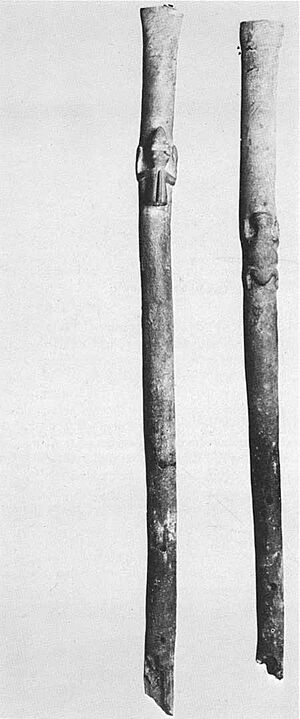Anasazi flute facts for kids
The Anasazi flute is a special type of ancient musical instrument. It's a prehistoric end-blown flute that archaeologists found in a huge cave in Arizona, United States. Scientists have been able to recreate these flutes today, allowing us to hear their unique sound.
Contents
Discovering the Anasazi Flute
Where Were They Found?
In 1931, a team of archaeologists led by Earl H. Morris explored 15 caves in Prayer Rock Valley, Arizona. The biggest cave they found was very important. It had 16 ancient homes, called dwellings, inside it.
The Broken Flute Cave
This large cave also held many interesting artifacts, including several wooden flutes. Because of these musical finds, the site was named the Broken Flute Cave. This discovery helped us learn a lot about the music and culture of the ancient people who lived there.
What Are Anasazi Flutes Like?
Ancient Flute Features
The flutes found in the Broken Flute Cave are very old. Scientists have used special methods to figure out their age. They were made between the years 620 and 670 AD.
All these flutes were crafted from a type of wood called Box elder. They each have six holes for fingers, which are called tone holes. To play them, you blow into one end of the flute.
How They Compare to Other Flutes
The Anasazi flute is similar in some ways to a Hopi flute. However, a Hopi flute usually has only five finger holes, while the Anasazi flute has six.
Dating the Flutes
In 2007, scientists did a more detailed study using a method called radiocarbon dating. This method helps to find the exact age of ancient objects. They tested one item from a burial pit in the Broken Flute Cave. This test showed the artifact was from between 599 and 769 AD. This helps us understand when these flutes were used.
The Anasazi Flute Today
Bringing the Music Back
In recent years, people have started to make and play Anasazi flutes again. They have been added to the list of important flutes from around the world.
Playing the Flute
Even though the Anasazi flute can be tricky to play, it makes a beautiful sound. It has a rich, warm voice and can play a wide range of notes, covering more than three octaves. This means it can make both very low and very high sounds.


